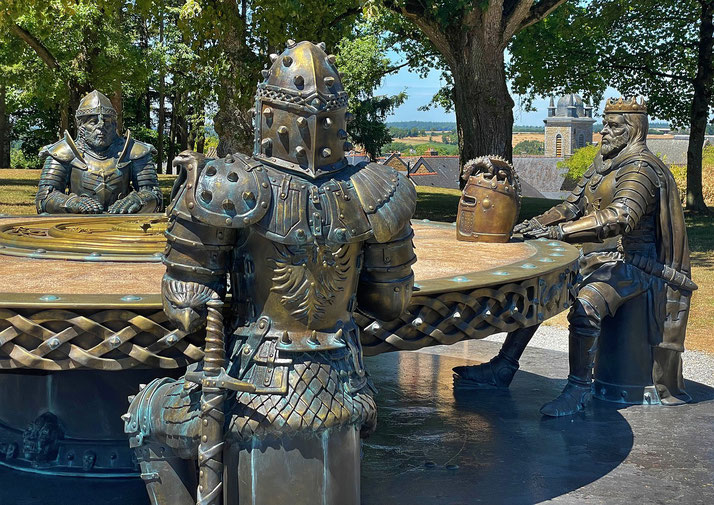Is there any historical evidence for King Arthur?

Legends thrive where written records are vague, and preserve the names and deeds of those whom history only mentions briefly. King Arthur is a powerful example of this phenomenon.
The search for his presence in historical sources has been an ongoing challenge for historians, and they have had to read between the lines of medieval texts and sift through centuries of embellishment in the hope of glimpsing the real person behind the legend.
Who was King Arthur?
According to legend, King Arthur was a British war leader who lived during the late 5th and early 6th centuries, a time of political fragmentation and constant warfare following the Roman withdrawal from Britain.
He is usually portrayed as a figure who defended the Britons from Saxon invaders and restored some measure of order and resistance in the chaos that followed.
Traditional stories describe him as the commander of a noble band of knights who operated from a grand court at Camelot and upheld values of justice and courage.
Many versions of Arthur’s tale include mythical elements such as a magical sword named Excalibur, a wise wizard called Merlin, and a tragic queen, Guinevere.
Over time, the image of Arthur shifted from a military leader to a model king.
However, there is no reliable evidence from his supposed lifetime that mentions him directly.
Some historians have suggested that Arthur may be based on figures such as Ambrosius Aurelianus, a Romano-British commander mentioned by Gildas, or Riothamus, a 5th-century British king who campaigned in Gaul.
Much of what people believe about Arthur today comes from medieval literature written centuries after he may have lived.
What historical sources do we have?
The closest available records come from writers who lived at least 300 years after the time period suggested above.
These authors depended heavily on oral and regional folklore alongside surviving records, which makes it difficult to separate historical fact from literary invention.
Notably, Gildas, who wrote De Excidio et Conquestu Britanniae around 540, describes the Britons' resistance against the Saxons and mentions the Battle of Mount Badon, but he does not refer to Arthur at all.
Similarly, Bede’s Church History of the English People, written in 731, discusses the same period and battle, but fails to name Arthur.
The first written sources that mention Arthur appear in texts put together in Wales and northern Britain.
These sources consist of battle lists and genealogical records that often incorporate brief annal entries.
However, they offer limited detail and raise questions about their trustworthiness.
Later chroniclers expanded on Arthur’s exploits, which turned him into a heroic figure who fought giants, conquered foreign lands, and ruled a united Britain.
Historia Brittonum (9th century)
The earliest surviving written reference to Arthur appears in the Historia Brittonum, which was compiled around 828 by a Welsh monk named Nennius.
This work includes a list of twelve battles that Arthur allegedly fought, including the Battle of the River Glein, the Dubglas, and Mount Badon.
It describes Arthur as the “dux bellorum,” or war leader, rather than as a king.
According to the text, Arthur is said to have led the Britons to a series of victories against the Saxons, culminating in a triumph at Badon, although the coherence and historicity of this list have been questioned by modern scholars.
The Historia Brittonum is troublesome as a source. It mixes traditional stories with local history and includes many stories about wondrous events and terrifying beings alongside visions of the future.
The battle list appears out of place and unconnected to other parts of the text, and the number twelve may have meant to represent ideas instead of actual events.
Some historians suggest that Nennius drew upon earlier spoken traditions or invented the list to encourage national pride.
The absence of support from other sources makes the reliability of this reference uncertain.
Annales Cambriae (10th century)
Another early reference to Arthur appears in the Annales Cambriae, also called the Welsh Annals, a record of events in Britain written around the mid-10th century.
It includes two entries connected to Arthur. The first claims that Arthur fought at the Battle of Badon and carried the cross of Christ on his shoulders for three days and nights.
The second reports that he was killed at the Battle of Camlann alongside a figure named Medraut, often identified with Mordred.
The often given dates of 516 and 537 are later scholarly estimates and are not found directly in the manuscript.
The entries in the Annales Cambriae are short and offer no detail about who Arthur was or what role he played in wider events.
However, they suggest that the memory of an Arthur figure was strong enough to be included in a historical record.
The way the manuscript was copied shows that these entries may have been copied from earlier sources that are no longer available.
Experts disagree on how much weight these entries should carry.
Geoffrey of Monmouth (12th century)
The most important account of Arthur comes from Geoffrey of Monmouth, who wrote the Historia Regum Britanniae around 1136.
This work portrays Arthur as a king of Britain who took control of large areas of northern Europe and held court at Camelot.
Geoffrey said he based his work on an ancient British source given to him by a cleric.
However, no such source has ever been found, and much of the material appears to be his own creation or taken from earlier legends.
Geoffrey’s version of Arthur introduced many of the characters now associated with the legend, such as Merlin, Uther Pendragon, and Mordred.
He also provided a full story of Arthur’s life, including his conception, reign, and final battle.
However, his work was clearly fiction. Nevertheless, it became widely accepted as history throughout the Middle Ages.
It encouraged later writers and helped the story spread across Europe, particularly through translations into French and other languages.
Geoffrey’s account also inspired medieval monarchs, such as the Plantagenets, to link themselves to Arthurian images to justify their rule.

Later authors
Following Geoffrey’s account, writers such as Wace and Layamon added more details to the story.
Wace wrote the Roman de Brut around 1155 in which he introduced the Round Table, while Layamon wrote his version of the Brut in the 1190s and gave the legend a more English style.
In the 13th century, French authors added tales of Lancelot, the Holy Grail, and courtly love, and this transformation made Arthur’s court the focus of knightly virtue and Christian morality.
These works included the Vulgate Cycle, composed by Cistercian monks in northern France.
Later, Le Morte d’Arthur by Thomas Malory in the 15th century became the standard account of Arthur in the English-speaking world.
He drew upon earlier sources but shaped them into a single narrative that presented Arthur as a tragic figure betrayed by those closest to him.
The story gained renewed popularity in the 19th century, especially in the poetry of Alfred, Lord Tennyson.
Over time, Arthur became a symbol of national identity and heroic kingship, even though the historical evidence remained unclear.
What archaeological evidence survives?
No confirmed archaeological site has yet been identified that can be directly linked to a historical King Arthur.
Places such as Tintagel in Cornwall and Cadbury Castle in Somerset have been associated with Arthurian tradition since at least the 12th century.
Excavations at Tintagel revealed a high-status settlement with imported Mediterranean pottery dating to the 5th and 6th centuries, suggesting a wealthy local ruler may have lived there.
In 1998, archaeologists discovered the so-called "Artognou stone" at Tintagel, bearing a Latin inscription with the name 'Artognou.'
Some have speculated a connection to Arthur, though the name is unrelated in language and the claim is widely seen as unsupported.
Cadbury Castle, a large Iron Age hillfort, was reoccupied during the post-Roman period and fortified with timber defences.
Archaeologists led by Leslie Alcock in the 1960s found evidence of occupation in the period often linked to Arthur.
Local traditions claimed it was Camelot, and some medieval writers believed this as well.
However, no inscriptions, artefacts, or structures have been discovered that mention Arthur or confirm the identity of the site’s inhabitants.
Why is the Arthurian legend so popular?
Since the Middle Ages, the Arthurian legend has captured public imagination because it combines adventure, magic, romance, and national pride.
Writers and rulers used the story to promote chivalric ideals. Kings such as Edward I and Henry VII invoked Arthurian images to connect their reigns with the idea of a glorious British past.
The legend also allowed medieval audiences to explore Christian values through the quest for the Holy Grail and the moral challenges faced by the knights.
In modern times, the Arthurian legend has remained popular through novels, films, television, and video games.
Its ability to adapt to different eras and audiences has helped it endure. Literary works such as Tennyson’s Idylls of the King, T. H. White’s The Once and Future King, and even satirical portrayals such as Monty Python and the Holy Grail have kept the story relevant.
Whether used to comment on war, politics, or personal sacrifice, the legend of Arthur continues to provide an adaptable and engaging narrative.
The absence of clear historical details has made it easier to change for different purposes.
What can we conclude?
As we mentioned above, although Arthur appears in a number of medieval sources, none of them were written during his supposed lifetime.
Also, no physical evidence has been found that confirms Arthur’s existence. While some historians, such as Christopher Gidlow, argue that the sources keep a memory of a real leader, others, such as Nicholas Higham, maintain that Arthur is entirely fictional.
Arthur’s lasting presence in history and literature has more to do with what people wanted to believe than what can be proven.
His story gave meaning to Britain’s past during periods of upheaval. Even without solid evidence, Arthur continues to stand at the edge of history and legend, a figure more at home in the imagination than in the historical record.
What do you need help with?
Download ready-to-use digital learning resources
Copyright © History Skills 2014-2025.
Contact via email
With the exception of links to external sites, some historical sources and extracts from specific publications, all content on this website is copyrighted by History Skills. This content may not be copied, republished or redistributed without written permission from the website creator. Please use the Contact page to obtain relevant permission.





